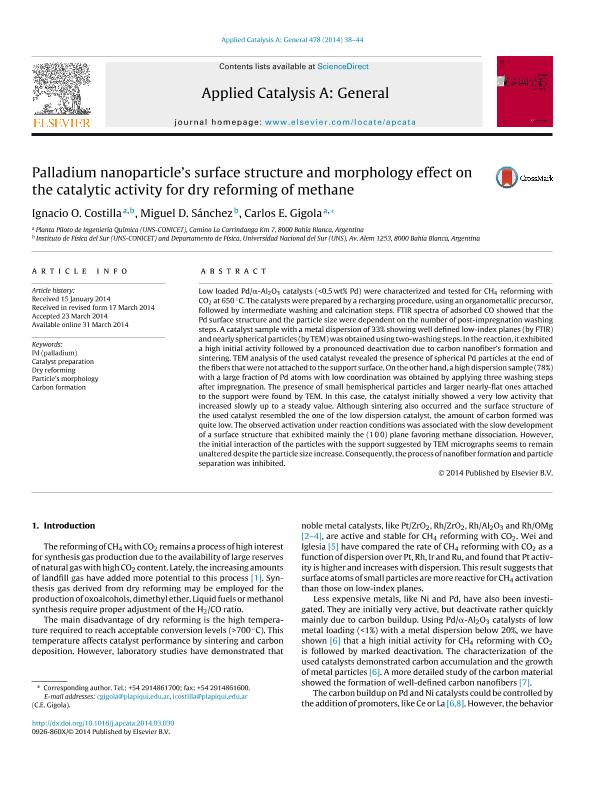Artículo
Palladium nanoparticle's surface structure and morphology effect on the catalytic activity for dry reforming of methane
Fecha de publicación:
31/05/2014
Editorial:
Elsevier Science
Revista:
Applied Catalysis A: General
ISSN:
0926-860X
Idioma:
Inglés
Tipo de recurso:
Artículo publicado
Clasificación temática:
Resumen
Low loaded Pd/α-Al 2 O 3 catalysts (<0.5 wt% Pd) were characterized and tested for CH 4 reforming with CO 2 at 650 °C. The catalysts were prepared by a recharging procedure, using an organometallic precursor, followed by intermediate washing and calcination steps. FTIR spectra of adsorbed CO showed that the Pd surface structure and the particle size were dependent on the number of post-impregnation washing steps. A catalyst sample with a metal dispersion of 33% showing well defined low-index planes (by FTIR) and nearly spherical particles (by TEM) was obtained using two-washing steps. In the reaction, it exhibited a high initial activity followed by a pronounced deactivation due to carbon nanofiber's formation and sintering. TEM analysis of the used catalyst revealed the presence of spherical Pd particles at the end of the fibers that were not attached to the support surface. On the other hand, a high dispersion sample (78%) with a large fraction of Pd atoms with low coordination was obtained by applying three washing steps after impregnation. The presence of small hemispherical particles and larger nearly-flat ones attached to the support were found by TEM. In this case, the catalyst initially showed a very low activity that increased slowly up to a steady value. Although sintering also occurred and the surface structure of the used catalyst resembled the one of the low dispersion catalyst, the amount of carbon formed was quite low. The observed activation under reaction conditions was associated with the slow development of a surface structure that exhibited mainly the (1 0 0) plane favoring methane dissociation. However, the initial interaction of the particles with the support suggested by TEM micrographs seems to remain unaltered despite the particle size increase. Consequently, the process of nanofiber formation and particle separation was inhibited.
Archivos asociados
Licencia
Identificadores
Colecciones
Articulos(IFISUR)
Articulos de INSTITUTO DE FISICA DEL SUR
Articulos de INSTITUTO DE FISICA DEL SUR
Articulos(PLAPIQUI)
Articulos de PLANTA PILOTO DE INGENIERIA QUIMICA (I)
Articulos de PLANTA PILOTO DE INGENIERIA QUIMICA (I)
Citación
Costilla, Ignacio Oscar; Sanchez, Miguel Dario; Gigola, Carlos Eugenio; Palladium nanoparticle's surface structure and morphology effect on the catalytic activity for dry reforming of methane; Elsevier Science; Applied Catalysis A: General; 478; 31-5-2014; 38-44
Compartir
Altmétricas




